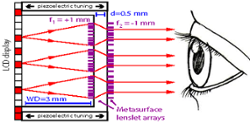UNM researchers tackle next generation of VR display
Virtual reality (VR) gains popularity every day and the technology is poised to bring major changes to various fields, including medical and mental health, education, business, architecture, sports, automotive safety, and, of course, entertainment. But one visual issue called “vergence-accommodation conflict” is a problem for VR developers and the people who use VR.
and the technology is poised to bring major changes to various fields, including medical and mental health, education, business, architecture, sports, automotive safety, and, of course, entertainment. But one visual issue called “vergence-accommodation conflict” is a problem for VR developers and the people who use VR.
A team of researchers from University of New Mexico, including Victor Acosta and Max Aiello of the Quantum Nanophotonics and Biosensing Team in the Center for High Technology Materials, are working to overcome the issue. Funding for the project came from the Google Faculty Research Award by Google's virtual reality division.
Vergence accommodation conflict occurs in VR as the eye struggles to coordinate between the headset screen on your face and the virtual scenario in the distance. The effects include an “off-kilter” feeling, fatigue, discomfort, motion sickness, and hindered performance.
"Recently there has been an explosion in the field of nanophotonic metasurfaces. These are nanofabricated optical structures that function as traditional glass optics, but in a very thin package, as thin as a piece of paper. This allows us to design displays that offer comparable or even superior performance to their bulky glass optics counterparts, while offering a slim form factor and potentially driving down the cost," Acosta said.
The UNM researchers’ approach is to develop an array of metasurfaces that will be aligned to correct and tune the various elements of the VR experience and reduce the negative side effects. The computing power at the UNM Center for Advanced Research Computing allows the researchers to tackle the large computational problem requiring “high-speed finite-difference time-domain electromagnetics simulations.” The simulations of the various arrays can be run numerous times using the high-performance computing at CARC to find the ideal combination.
“We hope to deliver a working prototype to the optical scientists at Google by the end of 2018. But these are just the first steps. Next, we’ll study the interplay between multiple metasurfaces placed within nanoscale proximity of each other to provide new function, such as wider field of view and greater resilience against various optical aberrations. Eventually we intend to exploit the tunability and versatility of these computational displays to help actively correct VR/AR displays for individual users' vision problems, such as macular degeneration,” Acosta said.
Solving the vergence-accommodation conflict would allow users to use VR displays without visual discomfort or nausea, he added.
His team is not alone, as other scientists rush to solve the vision-boggling obstacle too.
Wired Magazine quotes vision scientist Martin Banks as saying, “It’s an exciting area of research. I think it’s going to be the next big thing in displays.”
Acosta is an assistant professor of physics. Aiello is a is a physics graduate student doing his Ph.D. research in Acosta’s lab.
Also on the research team with Acosta and Aiello are
- Adam Backer, a Truman Fellow at Sandia National Laboratories
- John Perreault, a senior optical physicist at Google
- Patrick Llull, Optics hardware engineer at Google
For details about Acosta’s research, see his website.
